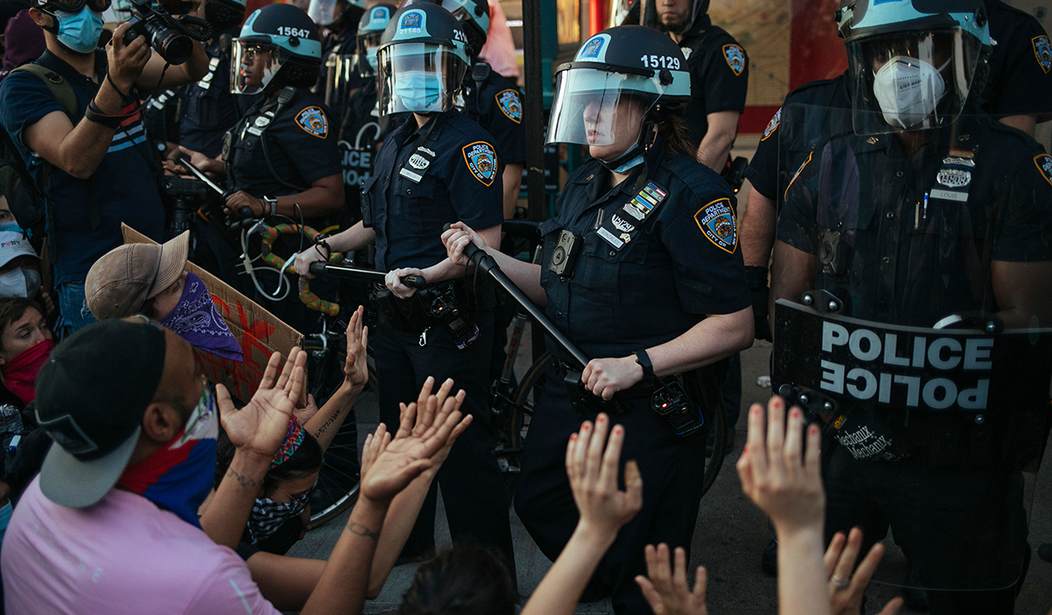The protests and riots that began in the wake of the death of George Floyd show no signs of stopping anytime soon. Lots of well-intentioned people are expressing their outrage over what they believe to be an epidemic of racist police brutality. Perhaps the most common form of alleged racist police “brutality” we hear about is shootings, particularly those with questionable justification. To hear some people, there’s an epidemic of racist police brutality and we need to do something about it.
Black Lives Matter is calling on the defunding of police—which is just silly. Congressional Democrats are looking to pass sweeping “police reform,” and one can only wonder what their real objectives are. But, this all leads to some very important questions. While we all agree that unjustified police brutality is bad, is there really an “epidemic” of racial bias in police brutality? It only takes one incident to go viral and serve as a call to arms for thousands of people to protest, but is it a really as big of a problem as people suggest it is?
Looking at the data, the answer might actually be no. According to a 2019 study published in the Proceedings of the National Academy of Sciences, white officers are not more likely to shoot black civilians than black or Hispanic officers are. According to the study, there is “no evidence of anti-Black or anti-Hispanic disparities across shootings, and White officers are not more likely to shoot minority civilians than non-White officers. Instead, race-specific crime strongly predicts civilian race. This suggests that increasing diversity among officers by itself is unlikely to reduce racial disparity in police shootings.”
Other studies have reached similar conclusions, including a Harvard study that found no racial bias in police using deadly force, though there is some disparity when it comes to physical force. With regard to lethal force, however, no disparity exists.
“A solid body of evidence finds no structural bias in the criminal-justice system with regard to arrests, prosecution or sentencing,” explained Heather Mac Donald of the Manhatten Institute in the Wall Street Journal earlier this week. “Crime and suspect behavior, not race, determine most police actions.”
In 2019 police officers fatally shot 1,004 people, most of whom were armed or otherwise dangerous. African-Americans were about a quarter of those killed by cops last year (235), a ratio that has remained stable since 2015. That share of black victims is less than what the black crime rate would predict, since police shootings are a function of how often officers encounter armed and violent suspects. In 2018, the latest year for which such data have been published, African-Americans made up 53% of known homicide offenders in the U.S. and commit about 60% of robberies, though they are 13% of the population.
The police fatally shot nine unarmed blacks and 19 unarmed whites in 2019, according to a Washington Post database, down from 38 and 32, respectively, in 2015. The Post defines “unarmed” broadly to include such cases as a suspect in Newark, N.J., who had a loaded handgun in his car during a police chase. In 2018 there were 7,407 black homicide victims. Assuming a comparable number of victims last year, those nine unarmed black victims of police shootings represent 0.1% of all African-Americans killed in 2019. By contrast, a police officer is 18½ times more likely to be killed by a black male than an unarmed black male is to be killed by a police officer.
“However sickening the video of Floyd’s arrest, it isn’t representative of the 375 million annual contacts that police officers have with civilians,” she said.
Mac Donald also noted that “A 2015 Justice Department analysis of the Philadelphia Police Department found that white police officers were less likely than black or Hispanic officers to shoot unarmed black suspects.”
Mac Donald has been writing about this subject for a long time. In a 2016 piece called “The Myth of the Racist Cop” she pointed out that police officers “are second-guessing their own justified use of force for fear of being labeled racist and losing their jobs, if not their freedom.”
On Oct. 5 a female officer in Chicago was beaten unconscious by a suspect in a car crash, who repeatedly bashed her face into the concrete and tore out chunks of her hair. She refrained from using her gun, she said, because she didn’t want to become the next viral video in the Black Lives Matter narrative.
The Chicago Police Department now wants to institutionalize such dangerous second-guessing. Its proposed guidelines for using force would require cops to consider the “impact that even a reasonable use of force may have on those who observe” it.
The following breakdown from Law Enforcement Today also puts the issue of police brutality in perspective:
- According to 2019 data, there are 328, 240, 469 people here in the United States.
- According to stats from com, there are 670,279 full time police officers here in the United States out of a total of 900,000 sworn law enforcement officers (data from National Law Enforcement Memorial Fund).
- There are approximately 2.1 police officers per thousand people.
- Police officers are less than .21 % of population.
- Officers come into contact with 17% of the population annually.
That means 55,800,880 contacts
- Which, at the time of the last report, led to 26,000 excessive force complaints against officers.
- That’s 0.047% of contacts.
- Only 8% of those complaints were sustained.
- That’s 2,080 out of 53,380,000 contacts, or .0039%
A good friend of mine who is a Chief of Police put that into perspective:
- You are seven times more likely to be murdered …
- 15 times more likely to be killed in a traffic accident …
- 42 times more likely to be raped …
… than to have a police officer use excessive force on you.
Simply put, the narrative that police officers are overwhelmingly racist is simply not true, and has likely contributed to police being assaulted or killed. During the rise of the Black Lives Matter movement, Barack Obama perpetuated the myth of systemic police racism, described by some as a “war on cops,” resulting in a spike of cops killed in the line of duty—a spike that ended during Trump’s first year in office. In fact, the number of cops killed in the line of duty went up annually from 2013-2016.
So, cooler heads must prevail when it comes to this issue. Cops who use excessive force must be dealt with appropriately, but perpetuating the myth of a widespread epidemic of racist cops helps no one, and likely does more damage. We literally have people calling for the defunding of police. While there may be a few bad cops out there, we rely on them to protect our communities.
_____
Matt Margolis is the author of Trumping Obama: How President Trump Saved Us From Barack Obama’s Legacy and the bestselling book The Worst President in History: The Legacy of Barack Obama. You can follow Matt on Twitter @MattMargolis










Join the conversation as a VIP Member